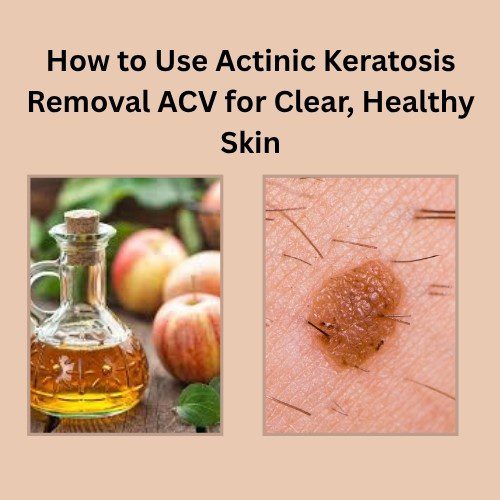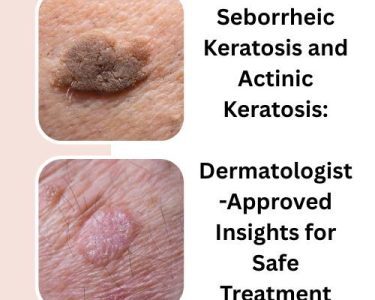Actinic keratosis (AK) — also called solar keratosis — is a common precancerous skin condition caused by long-term sun exposure. These rough, scaly patches or small crusty spots often appear on areas frequently exposed to sunlight, such as the face, scalp, hands, and arms. While medical treatments like cryotherapy, laser therapy, and topical medications are effective, many people are turning to Natural Remedies for Actinic Keratosis that can be used safely at home.
One such natural remedy that has gained significant attention is apple cider vinegar (ACV). The potential of actinic keratosis removal ACV has become a trending topic among those seeking non-invasive, affordable, and holistic skincare options. In this detailed guide, we’ll explore how ACV may help, how to use it safely, and what precautions to take for achieving clear, healthy skin.
Understanding Actinic Keratosis
Before jumping into treatment methods, it’s essential to understand what actinic keratosis is and why it needs attention.
What is Actinic Keratosis?
Actinic keratosis is a precancerous lesion caused by damage from ultraviolet (UV) radiation. Over time, sun exposure causes DNA mutations in skin cells, leading to rough, scaly patches that can feel like sandpaper.
While AK itself is not cancer, it can progress into squamous cell carcinoma (SCC) — a form of skin cancer — if left untreated. Hence, early management is crucial.
Symptoms of Actinic Keratosis
Common signs include:
- Dry, scaly patches or bumps on sun-exposed areas
- Rough texture, often easier to feel than see
- Pink, red, or brown spots that may crust or flake
- Itching or burning sensations
- Tenderness or bleeding in advanced stages
Who is at Risk?
People at higher risk include:
- Those with fair or light skin tones
- Individuals with a history of frequent sunburns
- People who spend long hours outdoors (farmers, drivers, athletes)
- Older adults (usually over 40)
- Individuals with weakened immune systems
Why People Use Apple Cider Vinegar (ACV)
Apple cider vinegar is a natural product made through the fermentation of apple juice. It contains acetic acid, enzymes, vitamins, and antioxidants that give it antibacterial, antifungal, and exfoliating properties. These traits have made ACV a popular ingredient in many natural skincare regimens.
When it comes to actinic keratosis removal ACV, the logic lies in ACV’s ability to:
- Exfoliate dead skin cells
- Create a mildly acidic environment that can help reduce abnormal skin growth
- Balance skin pH and limit bacterial or fungal colonization
- Dry out and peel away damaged skin layers, revealing healthier skin underneath
Although medical evidence is limited, many anecdotal reports suggest that consistent and careful use of ACV can help reduce the appearance and discomfort of actinic keratosis lesions.
The Science Behind ACV and Skin Health
Apple cider vinegar’s main component, acetic acid, has mild keratolytic (skin-shedding) properties. It helps to remove dead or abnormal skin cells while promoting regeneration. Other beneficial compounds in ACV include:
- Malic acid: A natural alpha-hydroxy acid (AHA) that helps exfoliate and brighten skin.
- Polyphenols: Antioxidants that combat oxidative stress caused by UV exposure.
- Probiotics: In raw, unfiltered ACV (“with the mother”), beneficial bacteria support skin microbiome balance.
These components may explain why many people notice smoother, clearer skin after regular use.
How to Use Apple Cider Vinegar for Actinic Keratosis
If you want to try the actinic keratosis removal ACV method, it’s crucial to use it safely and consistently. Below is a step-by-step guide.
- 1. Choose the Right Type of ACV
Select organic, raw, unfiltered apple cider vinegar with “the mother.”
This type retains beneficial enzymes and bacteria that improve skin health.
Popular brands: Bragg, Dynamic Health, or any local organic ACV brand with visible sediment.
2. Patch Test First
Before applying ACV directly to any lesion:
- Mix 1 part ACV with 3 parts water.
- Apply a small amount to an unaffected area of your skin.
- Wait 24 hours to check for redness, burning, or irritation.
If your skin tolerates it, you can proceed with treatment.
3. Direct Application Method
What You Need:
- Organic apple cider vinegar
- Cotton ball or cotton pad
- Bandage or medical tape
- Water for dilution
Steps:
- Dilute the ACV: Mix one part ACV with one part water.
(If your skin is sensitive, increase water ratio to 2:1 or 3:1.) - Soak the cotton ball in the diluted ACV solution.
- Place it on the affected area and secure it with tape or a bandage.
- Leave it on for 15–30 minutes once or twice daily.
- Rinse the area thoroughly with cool water and pat dry.
- Apply a soothing moisturizer (like aloe vera gel or Dermvi Oil Control Moisturizer).
Repeat this routine daily for 1–3 weeks. Over time, the lesion may darken, dry out, and eventually flake off naturally.
4. ACV Soak Method (for Multiple Patches)
If you have several small lesions, an ACV soak might be more convenient.
How to Do It:
- Fill a bowl with warm water.
- Add 1–2 tablespoons of ACV.
- Soak a clean washcloth in the mixture and apply it to affected areas for 10–15 minutes.
- Rinse off and moisturize.
This method is milder and suitable for people with sensitive or dry skin.
5. ACV and Honey Mask
Honey has strong antioxidant and healing properties, making it an excellent companion to ACV.
Recipe:
- 1 teaspoon ACV
- 1 teaspoon raw honey
- 2 teaspoons water
How to Use:
- Mix ingredients well and apply to affected skin.
- Leave for 15 minutes.
- Rinse with lukewarm water and apply moisturizer.
Use this mask 3 times a week for a soothing, exfoliating effect.
6. ACV and Aloe Vera Combo
Aloe vera helps reduce irritation, redness, and inflammation.
Directions:
- Mix equal parts ACV and aloe vera gel.
- Apply to lesions with a cotton swab.
- Leave for 10–15 minutes and rinse.
This combination offers a cooling effect while maintaining the exfoliating benefits of ACV.
Expected Results and Timeline
Natural remedies take time, and patience is key. With consistent use:
- In the first week: The area may sting or look slightly red (normal reaction).
- After 2–3 weeks: The rough patch might dry, darken, and start peeling.
- After 4–6 weeks: New, smoother skin often replaces the old lesion.
However, results vary based on your skin type, severity of the lesion, and frequency of application.
Precautions When Using ACV for Actinic Keratosis
While ACV is natural, it is still acidic and must be handled carefully. Misuse can lead to burns, irritation, or scarring.
Important Safety Tips:
- Never use undiluted ACV on the skin—it can cause chemical burns.
- Do not pick or scratch the lesion as it heals.
- Avoid sun exposure on treated areas; always use sunscreen (SPF 50+).
- Stop immediately if you notice severe redness, swelling, or blistering.
- Consult a dermatologist if lesions persist or worsen after several weeks.
Remember, ACV is not a medical cure but a complementary option that may help improve skin texture and promote healing.
Other Natural Remedies to Complement ACV
To enhance results, you can combine actinic keratosis removal ACV with other gentle actinic keratosis home remedies and natural cures known to support skin repair.
- Green Tea Extract
Contains epigallocatechin gallate (EGCG), which helps repair sun-damaged cells. Apply cooled green tea bags or use green tea-based creams daily.
2. Coconut Oil
Has anti-inflammatory properties and helps moisturize peeling or healing skin after ACV application.
3. Vitamin E Oil
Encourages regeneration and reduces scarring once the lesion falls off.
4. Castor Oil
Softens and helps dissolve rough keratinized patches when applied nightly.
5. Dietary Support
Consume antioxidant-rich foods like:
- Leafy greens
- Berries
- Tomatoes
- Omega-3 fatty acids (from fish or flaxseed)
A healthy diet strengthens the skin’s natural repair process.
When to Seek Medical Advice
Even if home remedies like actinic keratosis removal ACV show improvement, professional evaluation is vital if you notice:
- Rapid growth or change in lesion color
- Bleeding or crusting
- Pain or swelling
- Multiple new lesions appearing quickly
Dermatologists may recommend procedures like cryotherapy, photodynamic therapy, or topical 5-fluorouracil if the condition persists or worsens.
Dermatologist’s Perspective on ACV Use
Most dermatologists acknowledge that while ACV can help exfoliate and disinfect, it should not replace clinical treatment for actinic keratosis. However, they recognize that mild home remedies, when used carefully, can be adjunctive to professional care — especially for those with mild lesions.
If you plan to use ACV, let your doctor know. They can guide you on combining it safely with prescribed medications or creams.
Long-Term Prevention Tips
Once your skin clears, maintaining healthy habits will help prevent recurrence.
1. Sun Protection
- Use broad-spectrum sunscreen (SPF 50 or higher) every day.
- Reapply every 2 hours when outdoors.
- Wear wide-brimmed hats and UV-protective clothing.
2. Regular Skin Checks
Examine your skin monthly for new patches or changes. Early detection saves time and prevents complications.
3. Hydration and Nutrition
Drink plenty of water and eat skin-nourishing foods rich in vitamin C, E, and zinc.
4. Skincare Routine
Use gentle cleansers and moisturizers. Avoid harsh scrubs or chemical peels that can irritate sensitive areas.
Conclusion
Using apple cider vinegar for actinic keratosis removal ACV is an increasingly popular home remedy that offers exfoliating, antibacterial, and skin-renewing benefits. While not a guaranteed cure, it can be an effective natural support for reducing mild lesions and improving overall skin health when used with caution.
Always remember that actinic keratosis is a precancerous condition, and while natural remedies can help manage symptoms, professional evaluation remains essential. Combine safe ACV usage with proper sun protection, a balanced diet, and consistent skincare habits to maintain clear, healthy, and radiant skin long-term.




